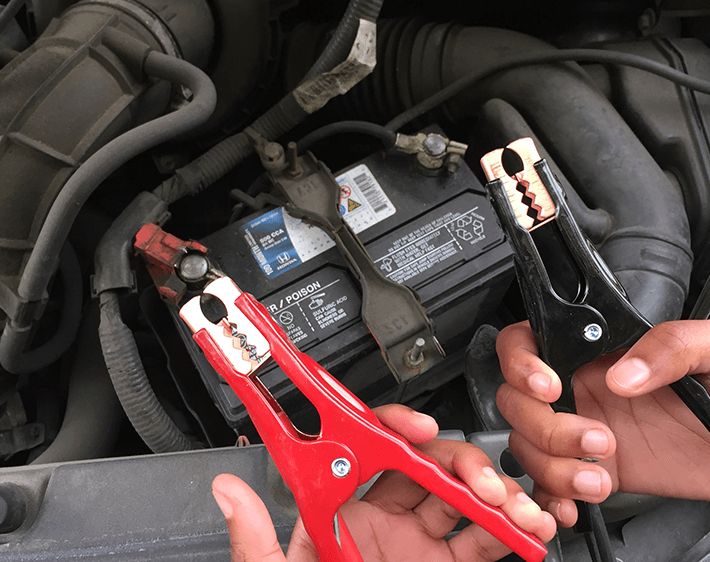Different Types of Car Batteries
Although a car battery's primary function is to start the car (with the exception of EV/Hybrid vehicle batteries, which keep it running), not all batteries are made exactly the same way! Like vehicle models and trims, batteries come in various types and “tiers” — varying in size, power, and features.
Flooded Lead-Acid Battery
A flooded lead-acid battery, also called a wet cell battery, is the most common type of battery installed in modern vehicles. Flooded lead-acid batteries are relatively affordable and easy to find. They can be recharged easily and can also work in many types of climates.
However, a lead-acid battery can have a shorter lifespan than its higher-performing counterparts, especially in extreme heat and cold. Additionally, as the name suggests, flooded lead-acid batteries are quite literally full of liquid — an electrolyte solution (a.k.a. battery acid). This means wet cell batteries must be kept upright, which limits their useability to certain vehicles. Additionally, the “liquid” nature of the battery acid within them makes them more prone to leakage and the resulting corrosion, which may call for maintenance.
There are two more specific classifications within the broader wet cell battery category — SLI (short for starting, lighting, and ignition batteries) and deep cycle batteries.
SLI Battery
SLI batteries are designed to provide the short-but-powerful burst of energy required to crank the engine on most non-electric passenger cars. Although SLI batteries can help power electronic accessories, they are not meant for long-term energy supply, relying on the alternator to remain charged. Using your SLI battery to power car accessories while the engine is not running can deplete its charge and shorten its lifespan overall.
Deep Cycle Battery
On the other hand, deep cycle batteries pack a one-two punch — they can provide the power surge required to crank an engine to life or deliver a steady stream of energy over a continuous period. Deep cycle batteries can often be found in recreational vehicles and boats, which often require electric power while the engine is not running.
Valve-Regulated Lead-Acid Battery
Another type of battery is a valve-regulated lead-acid (VRLA) battery. This type of car battery typically offers fewer maintenance demands than the standard flooded lead-acid battery since it is sealed. There are two types of VRLA batteries: gel cell and absorbed glass mat.
Gel Cell Battery
Gel cell batteries feature a gel solution as opposed to a liquid solution inside the battery. And while these batteries function like flooded lead-acid batteries, they are much tougher. These batteries have a higher resistance to heat, physical shock, and fluid evaporation, allowing them to last longer, in many cases.
Absorbed Glass Mat (AGM) Battery
Absorbed glass mat batteries use glass mats to hold the electrolyte fluid inside the battery as opposed to the fluid freely flooding the plates within the battery. Absorbed glass mat batteries function like flooded lead-acid batteries. However, since these batteries are sealed, there's little risk of a battery acid spill.
Electric Vehicle Batteries
With eco-friendly cars becoming increasingly common, it’s essential to recognize the importance of specialized electric vehicle batteries, or EVBs. Most electric vehicles currently on the market are equipped with lithium-ion batteries, which can be very cost-prohibitive, making them inaccessible to some consumers.
Cost and performance are currently two of the largest factors to consider in the ever-evolving world. Engineers and designers are looking for new ways to create a battery pack that lasts as long as possible while providing a more cost-effective solution.
Different Car Battery Group Sizes
Like your go-to pair of jeans, the right car battery (whether it’s an AGM or SLI) should fit your car just right — and that’s where battery sizes, officially known as “group sizes,” come in!
A car battery’s group size is determined by its length, width, and height. The right battery group size for your car can typically be found in your owner’s manual or using our car battery look-up tool.
Different Car Battery Terminal Types
It is also important to note that certain vehicle models and years require batteries with different terminal types and configurations. The terminals connect the battery to the car. The most common types of terminals found on vehicles today include SAE, JIS, and L terminals.
SAE terminals are cylindrical in shape. In terms of size, the positive post is generally larger than the negative one. On the other hand, JIS terminals are smaller and thinner, hence their nickname, “pencil posts.” Like SAE terminals, the positive post is larger than the negative one in JIS terminals.
Lastly, L-terminals, which are mostly found in European makes and other types of vehicles (like lawnmowers, for instance), look like small L-shaped brackets. The vertical end of L-terminals typically has a hole in the middle that the battery cables can be bolted onto.
Additionally, some vehicle makes and models require different terminal configurations — top post or side post. As their name suggests, this refers to the terminal placement in relation to the battery. For proper fitment, it is important to follow manufacturer specifications and ensure that all battery cables can easily connect to their respective terminals.
Different Car Battery Cold Cranking Amps
Have you ever noticed that your engine takes a little longer to rev to life on cold winter mornings? You’re not alone! It is not uncommon for batteries to have a “harder” time cranking engines to life when operating in extreme temperatures. That’s why the Battery Council International established a standard unit to measure, report, and compare each battery’s ability to deliver power in freezing temperatures. This standard unit of battery measurement is known as CCAs — cold cranking amperes.
However, CCAs are still a valuable measurement for your battery-purchasing decisions, especially if you live in a particularly cold climate. When deciding which battery to get for your car, a good rule of thumb is to always get one that meets or surpasses your manufacturer’s CCA recommendations.
How Do I Pick the Best Battery for My Car?
Choosing the right battery for your vehicle is an essential form of maintenance that can help keep it running smoother, longer. If you are looking for the best battery for your car, the upfront cost is undoubtedly a factor, but it shouldn’t be the only thing you consider.
Be sure to keep in mind:
- Your manufacturer’s recommendations: Checking the manufacturer-recommended service information for help finding the right battery for your car is perhaps the most critical factor in your battery-purchasing decision. The manufacturer knows your car best — they built it!
- Your main purpose for the vehicle: If you utilize your vehicle for particularly draining tasks, such as frequently taking short drives or hauling heavy loads, you could benefit from a more performance-focused battery.
- Your local climate: If you drive in an area with especially harsh winters, check that the replacement battery you get meets at least the minimum cold cranking amp requirements for your environment.
- Your vehicle’s electrical accessories and features: Cars with more electronic features, such as automatic start-stop and heated seats, may require AGM batteries.
Get the Right Battery from Firestone
Is your car battery acting up? Don't gamble on a new battery that isn't meant for your vehicle! Head to your local Firestone Complete Auto Care for free battery testing and expert battery replacement services. We'll test your current battery to ensure it has enough charge to keep you going and replace it if necessary.




